But what is SEO writing? How do you write for search engines while still writing for the people who use them? Is there a process anyone can follow to be a better SEO writer?
In this guide, I’m going to answer all of these questions and give you a step-by-step approach to creating perfectly search-optimized content your readers (and Google) will love.
SEO writing is the process of writing content with the intent of ranking on the first page of a search engine, e.g., Google.
To do so, you must focus on three things:
- Know what searchers need when they search your target keyword (i.e., search intent)
- Create the best possible answer to a given search query (i.e., research and knowledge)
- Present the answer in a way that’s easy to read and understand (i.e., have good writing skills)
Beyond that, you also need to understand the basics of on-page SEO elements, such as meta tags, image alt text, internal links, etc. But I’ll get to those later.
For now, let’s explore this question: “Why should you even care?”
SEO writing is important because Google gets an estimated 3.5 billion searches per day. This means your customers are most certainly using Google to find information.
Additionally, once you rank on the first page of Google for your target keywords, you’re getting free, recurring, and highly relevant traffic to your website.
In other words, SEO = money in the bank.
As paid advertising costs rise and social media engagement becomes harder and harder to come by, organic traffic continues to dominate as one of the most important marketing channels any modern business can invest in.
So how do you get those coveted organic page #1 rankings?
Luckily for you, the process I use is fairly simple and easy to follow. Once I finish my keyword research and know what keyword(s) I’m targeting, every article I publish on my blog goes through the following seven SEO writing steps:
1. Research the SERPs for your target keyword(s)
Remember I said writing for SEO involves understanding search intent?
Search intent is the intention a searcher has when they type in a query. For example, if someone searches for “best restaurants near me,” their intention is to find a good restaurant near their current location.
Sounds simple, but it can be surprisingly easy to get wrong. And if you get it wrong, you have no hope of ranking on page #1 of Google—no matter how great your content is.
How could you get it wrong, you ask?
Let’s say you’re targeting the keyword “RV storage ideas.” At first, you may think this keyword will return results with ideas on how to store your RV when you’re not using it.
But if that’s what you think, you’re wrong. At least, in Google’s eyes. Here are the actual results:

As you can see, the top results for this keyword are all guides on how to get more storage inside your RV, not RV storage locations.
That’s why it’s so important to check the search engine results page (SERP) before you even start writing anything. You can do this quickly and easily with Ahrefs’ Keywords Explorer (as I did above) or by Googling the keyword.
Additionally, in the research stage, you’ll want to look for featured snippets. A featured snippet is a snippet of information Google takes from a ranking webpage and displays right in the search results:
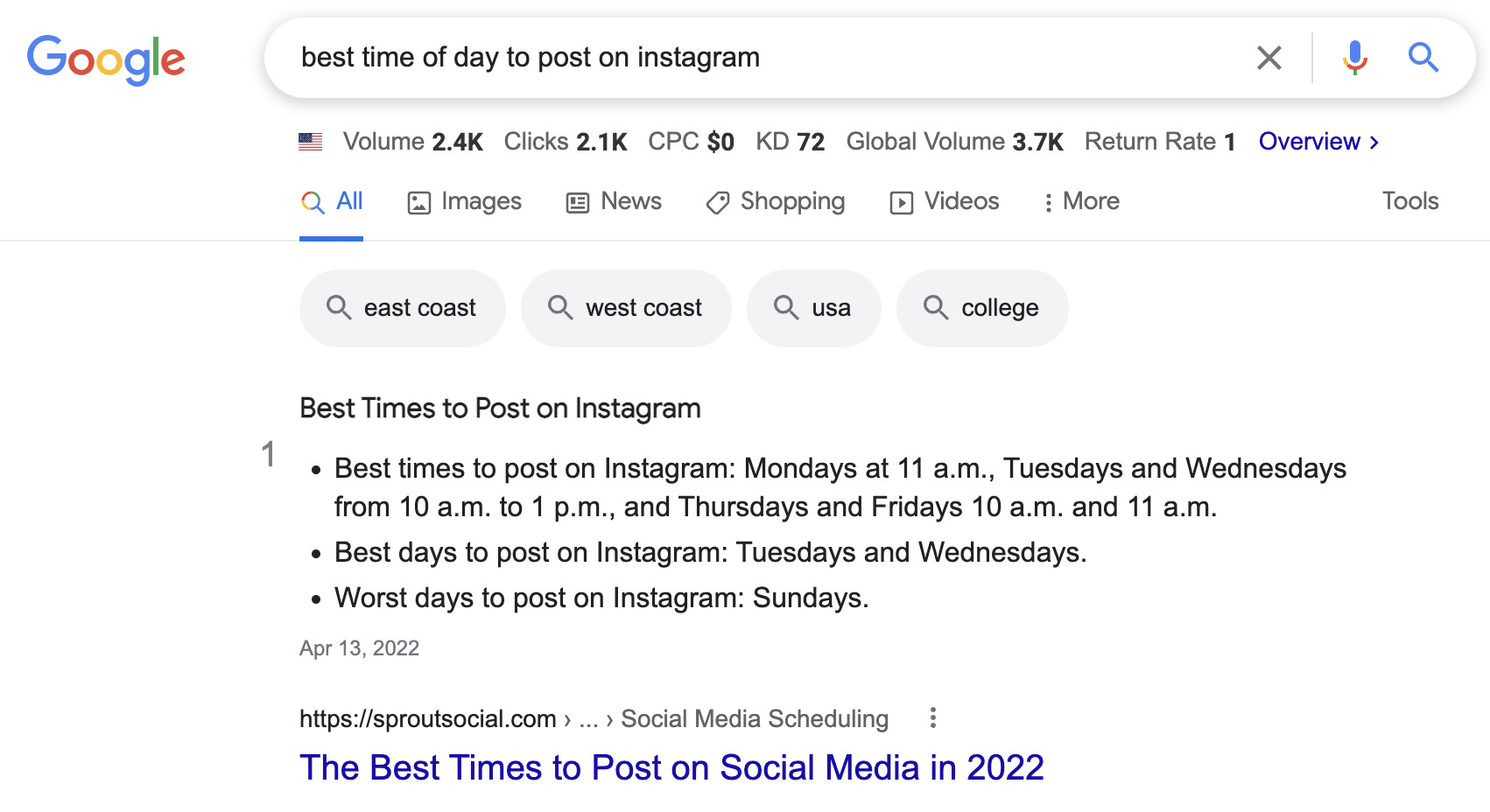
You can optimize your content for featured snippets like the one above as a way of bypassing some of the competitiveness of a keyword and ranking for it quicker.
The best way to quickly and easily find featured snippets is with Keywords Explorer. Just enter the keywords you’re thinking about targeting, click the dropdown “SERP features,” check off Featured snippet, and click “Apply.”
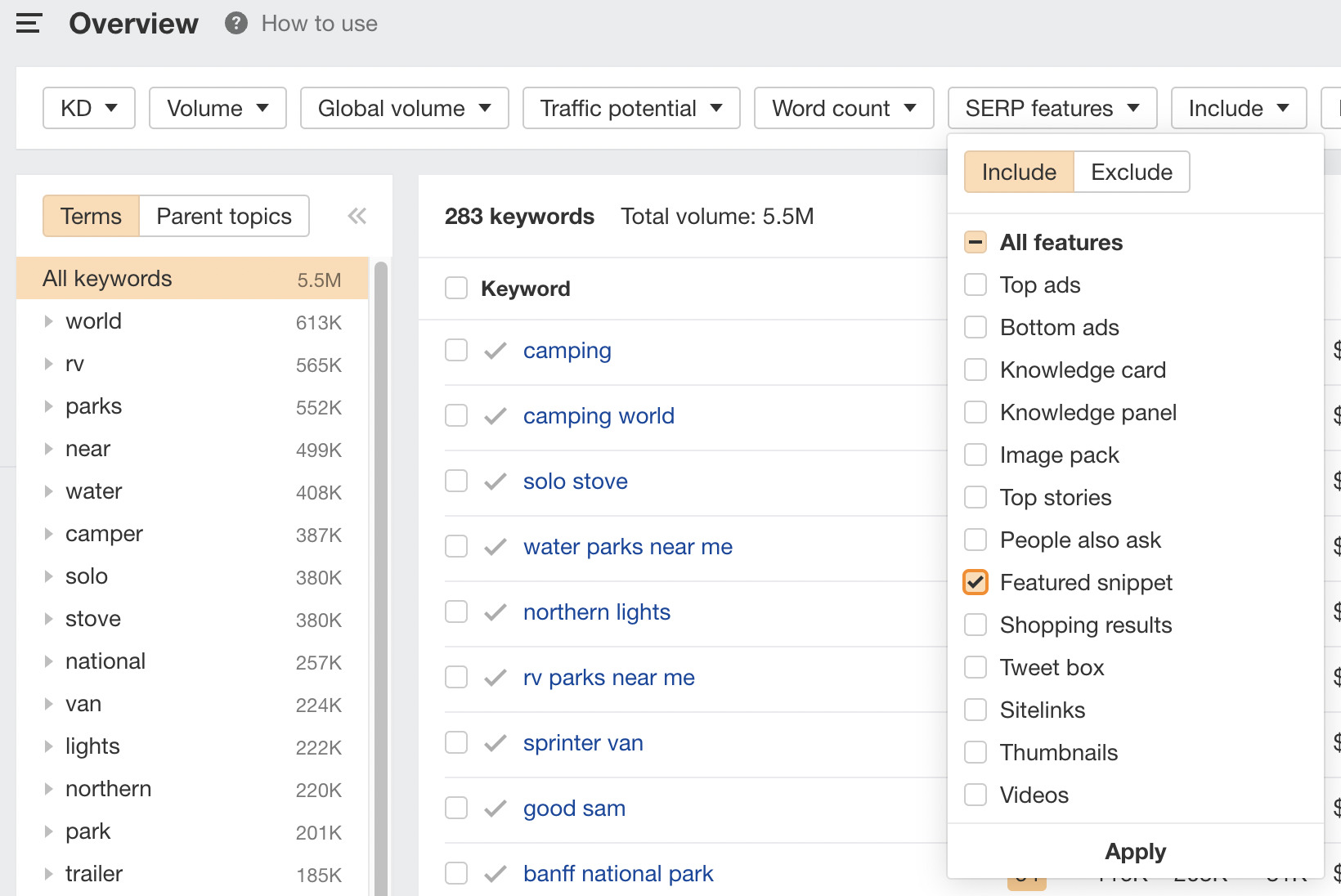
Now you’ll only be shown keywords that have a featured snippet! Follow our guide to optimizing for featured snippets to learn more about how you can implement these in your writing.
Once you understand search intent, there’s one more step to take before you start writing.
2. Create an article outline
Creating a content outline is a crucial step in SEO writing. An outline makes the writing process faster and easier while ensuring a high level of quality control.
Part of the outline process is filling in crucial SEO details, such as common questions people ask when searching for a given keyword.
Another part of the process is determining the heading and subheadings, goals, and approach angle of your article. What makes your article different from or better than all the others out there?
Here’s an example of part of the outline I made for one of my other articles:
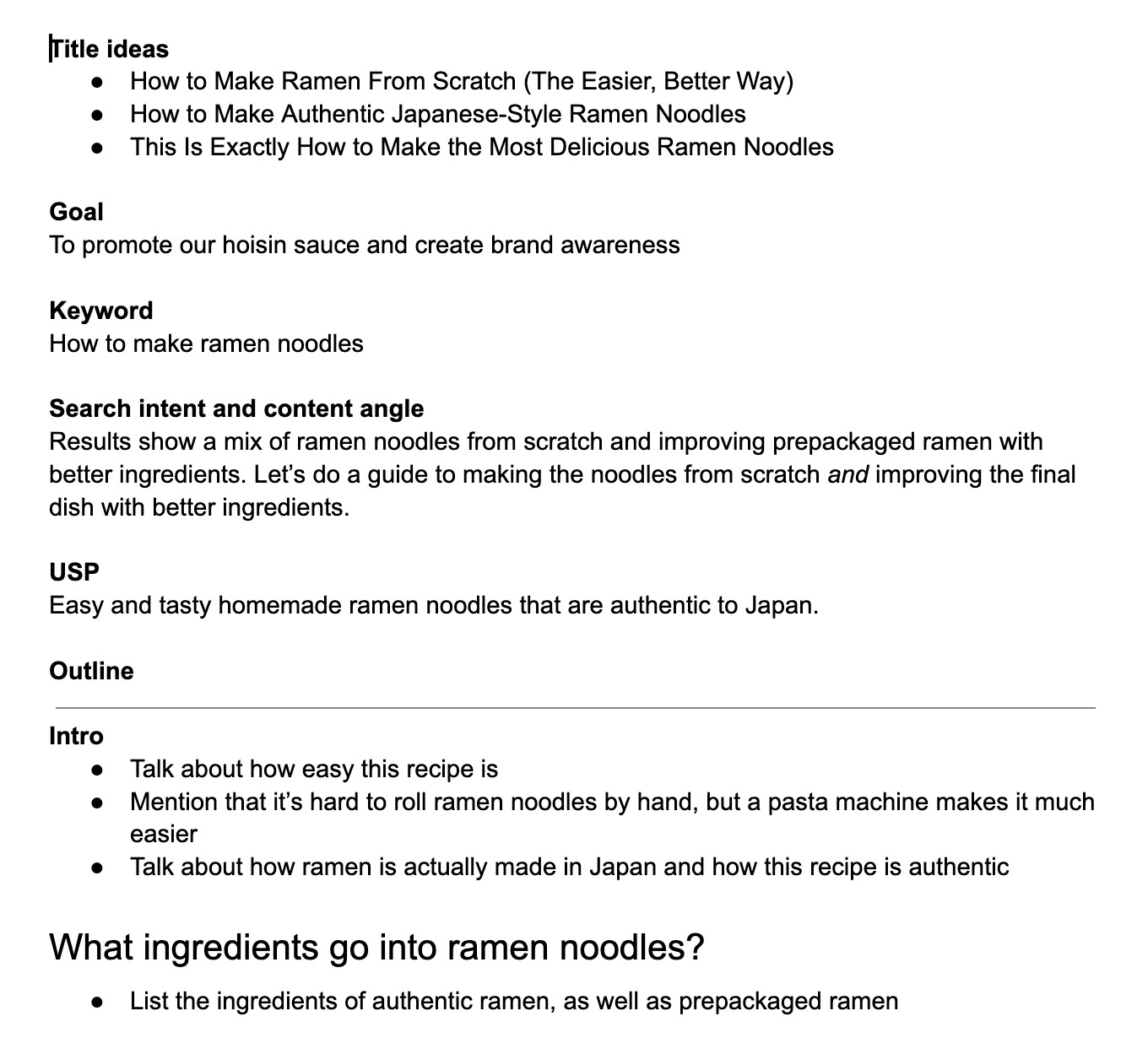
I’ve already written a guide to creating content outlines here, so head to that article for the details of this step.
3. Write your draft
Nearly every great article begins with a rough draft.
Why?
Because the draft process helps you refine your ideas and get the research phase done. And it helps you flesh out the flow of your content. Also, you get the opportunity to easily change and revise things without feeling like you’re starting over after having a finished product.
I always write my drafts in Google Docs. This allows for easy communication between my editors, designers, etc., and me. In fact, here’s what this very section looks like in draft form:
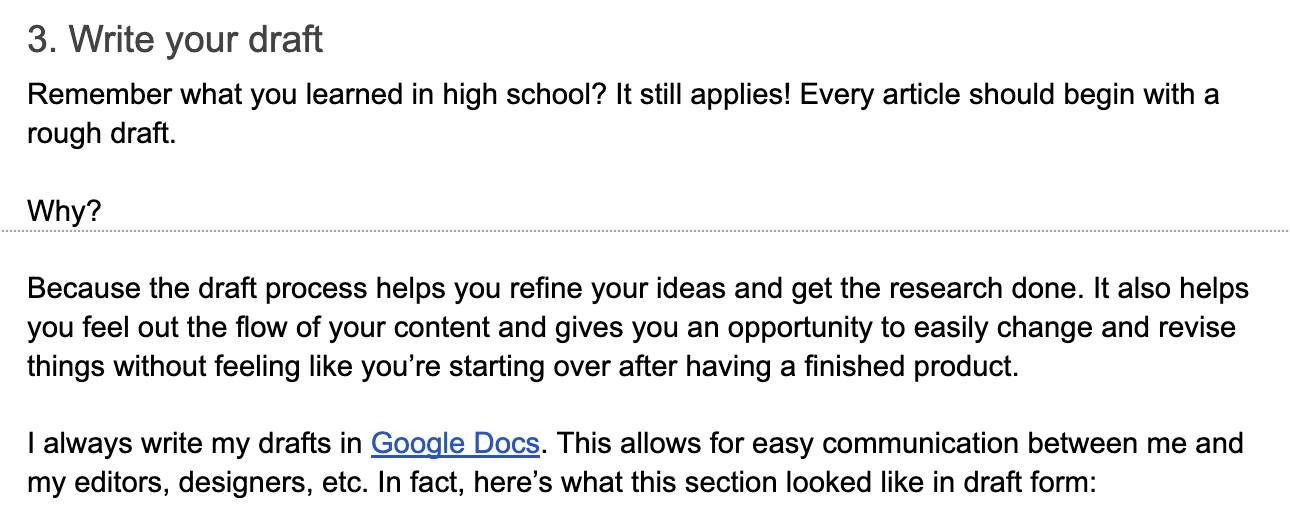
Your draft is the perfect time for free-flow writing without worrying too much about making the words perfect or formatting everything. Just get the meat of the content on the page.
4. Get feedback and revise the draft
While not always possible, getting feedback on your draft can be helpful. As writers, we often have trouble seeing the wood for the trees, so having a second pair of eyes never hurts.
If you have team members or employees, have them review the draft for you and give their thoughts. Better yet, if you have an audience, get their feedback as well.
A Facebook group or email list can be perfect for this. If you have a few trusted members, submit your draft to them to see what your actual customers think of your writing. They may offer feedback you didn’t think of. In fact, the feedback may contain information that isn’t even on Google yet.
Once you get the feedback, revise your writing accordingly. Then move on to step #5.
5. Edit and format the draft into a proper article
This is your time to polish the article.
Investing in an editor, if you don’t already have one, can dramatically improve your content quality. But if you can’t afford one, you can edit the content yourself.
How do you do that?
When I create SEO content, my goal is simple: provide the best possible answer in the fewest possible words in an easy-to-skim format.
So as you’re editing, ask yourself the following questions:
- Is this the best answer?
- Am I explaining it simply?
- Is this article easy for someone (with limited time) to skim and get what they need?
You can improve your writing by organizing your content better with headings and subheadings, using italics or bold to make key points stand out, and varying sentence length to keep things interesting.
It’s also a good idea to avoid overly complex words, as these can make your point difficult to understand. Of course, it’s fine to use more technical words if there’s no simpler way to explain something.
Finally, it’s a good habit to use photos, videos, and bulleted lists to break up long stretches of text and show your points visually. Having media may also help with SEO.
As you’re editing, consider reading your content out loud to yourself. Reading it out loud shows you where the dry or boring parts are, highlights where things get overly complicated or unclear, and can make grammatical errors stand out.
Speaking of grammar—Google Docs also automatically shows you where you misspelled something or made a grammatical error. This useful feature lets you focus on the quality of content rather than the technicalities when you’re editing.

6. Set your SEO elements and publish your post
While having a great article is a big step to rank on Google, it takes a bit more than that to achieve those page #1 rankings.
I mentioned on-page SEO at the beginning of this article. This refers to the following:
- Title tag
- Meta description
- Open graph tag
- URL slug
- Page or post categorization
- Image alt text
- And more
Every page on your site needs this optimization during the writing process. I personally use WordPress and have a plugin called SEOPress that allows me to set these things easily.
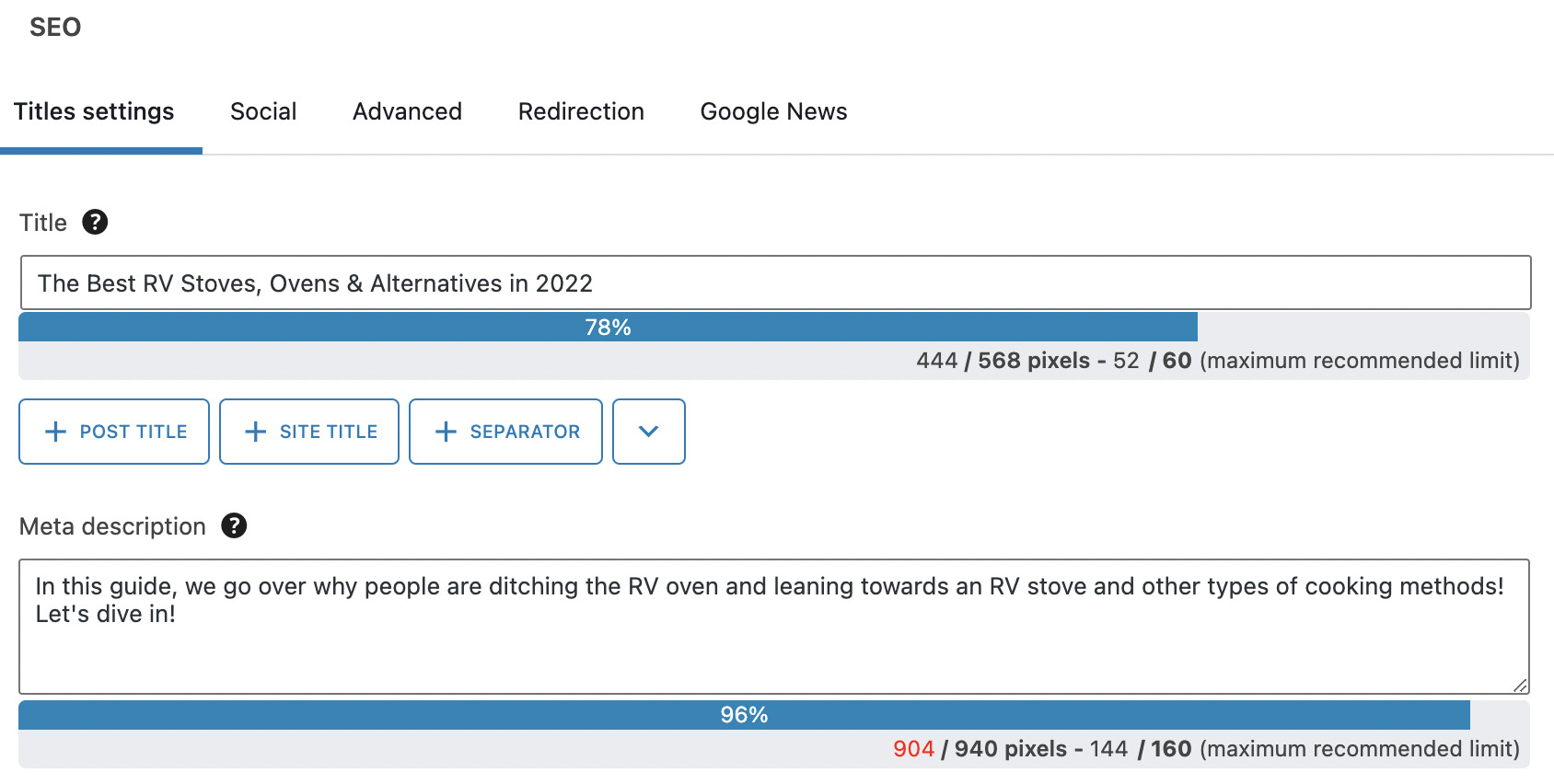
However, most content management systems (CMSs) have a plugin or setting where you can upload this data. If they don’t, I highly suggest switching to one that does!
But this post isn’t about on-page SEO. Though, you can refer to this guide if you want to learn more.
7. Update internal links
After your post is published, you should always add internal links from other pages on your site to the new article to help search engines and users navigate to it.
Not only does this make your site user-friendly, but it also helps Google crawl your site and establish what your new page is about (via anchor text) to properly index it.
An easy way to quickly identify internal link opportunities is with the Google search operator, site:. You use it by typing “site:yoursitehere.com [related keyword here]” into Google.
For example, when looking for internal link opportunities to this “SEO writing” page, I searched “site:ahrefs.com SEO writing”, and it returned over 1,000 pages with relevant text on the page.
(Obviously, we write a lot about SEO.)
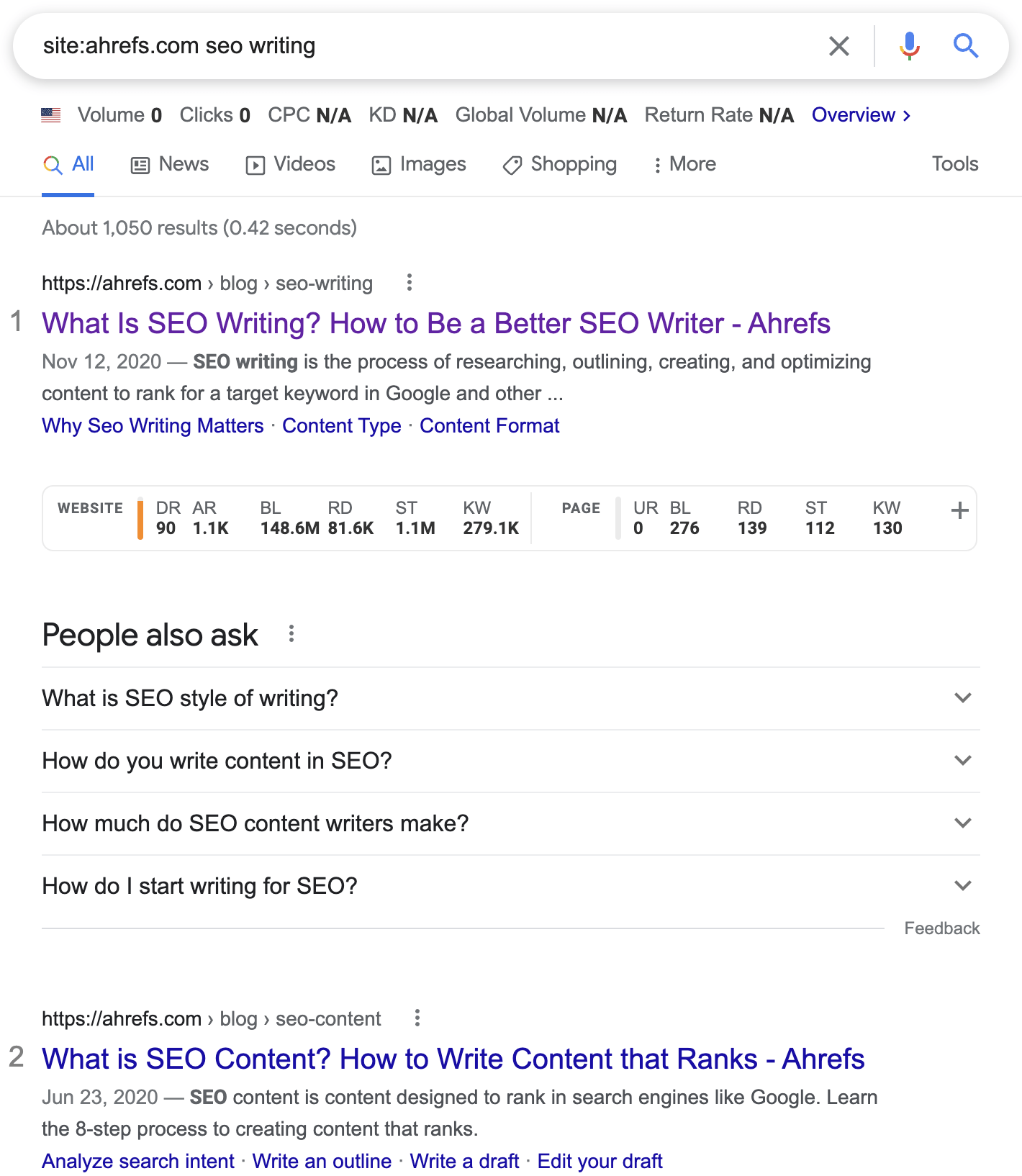
Scroll through the results of relevant articles and choose a few to add internal links that point to your newly published post.
If that search modifier doesn’t provide results that are relevant enough to find internal link opportunities, you can get even more hyper-relevant results with an exact-match search operator.
Sounds fancy. But all you have to do is put your keyword in quotes: site:ahrefs.com “SEO writing”.

I always aim to add at least three to five internal links to every new article. But this number depends on how many pages you currently have—you may want to add dozens or even hundreds of internal links if you have thousands or tens of thousands of pages.
Final thoughts
SEO writing boils down to creating the best possible answer to a given query presented in a way that’s easily understood and skimmable.
As long as you nail that and the basic on-page SEO best practices I mentioned, you’ve mastered the content side of SEO.
If you’re eager to learn more about writing and SEO, check out some of these other guides:
